Fresh from Alicante, we got behind the wheel of the cee'd 1.4 CVVT (100 hp), 1.0 T-GDI (100 hp) and 1.6 CRDi (136 hp). Yes, you read that right, there are two engines with identical power, and both are petrol engines. It is a very rare phenomenon in our market, to offer two engines of different technology and "similar" purpose. Normally, one engine replaces the other, and bye-bye very goodbye.
One of the most interesting points of this contact is to compare these two engines. On the one hand, a naturally aspirated four-cylinder engine with multi-point injection, on the other, a turbocharged three-cylinder with direct injection. Each has its advantages and disadvantages. We have also tested the new diesel, which gives more power, with a superior driving pleasure.
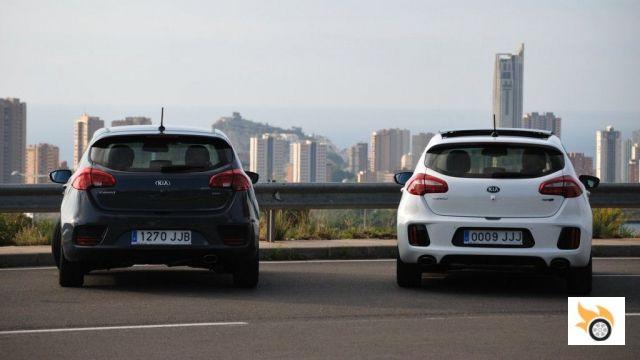
What changes in the new Kia cee'd?
Aesthetically we have to highlight changes in front bumper, grille and rear. The optical groups maintain their basic forms, but now one of the novelties is to have a similar aesthetic to the pro_cee'd GT (three-door top of the range) in the other two bodies, and with more normal engines. Look at the pictures, on the left a "Base", on the right a GT Line.
The new GT Line equipment variant is associated with the 1.0 T-GDI (120 hp) and 1.6 CRDi (136 hp) engines. It is designed as the new "black leg" version, the one with the most equipment. We can make a comparison with the FR of the SEAT Leon, first a performance version, then a line of equipment. Of course, in the case of Kia the GT Line has no dynamic modifications, except for the 17″ wheels.
Aesthetically, the pro_cee'd GT remain as they were.
At the rear we have LED lights. Depending on whether it's a GT Line or a lower model, the look changes noticeably. The GT Line have a double exhaust tailpipe (real), while the "Base" have only one tailpipe on the left. In the case of the SW (estate) it doesn't have two tailpipes, but a double tailpipe on the right side. It also gets new wheel designs and two body colours, one mustard-like and one silver.
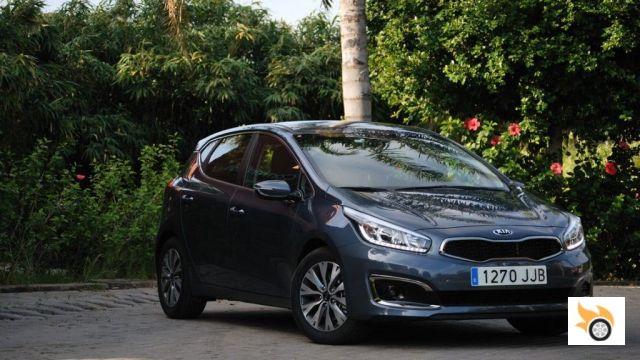
Inside, the basic lines are the same, but some materials and engine insulation have been modified. Where the reduction in noise, vibration and harshness (NVH) will be most noticeable is in the case of the "petrolheads". The difference in refinement from a current 1.6 CRDi to the first generation cee'd is savage. It's now worthy of wearing a premium badge on the nose, and I say that without hesitation.
I know the Kia cee'd very closely as it is one of my direct family cars. That 1.6 CRDi was much less refined, and was very poorly insulated. When the revs dropped below 1,250 RPM it would start to vibrate a lot... and in the new model, nothing like that. It goes rounder than a doughnut.
Now it runs so well that I've been pleasantly surprised.
In the diesel the isolation is so good, that even when the engine reaches 1,000 RPM (at full throttle) we can forget that we're driving a diesel. The secret is to double the foam in the carpet, ventilation system and engine compartment. If you close your eyes, you might think you're in an E-segment car. If you think I'm raving, I invite you to check it out for yourself.
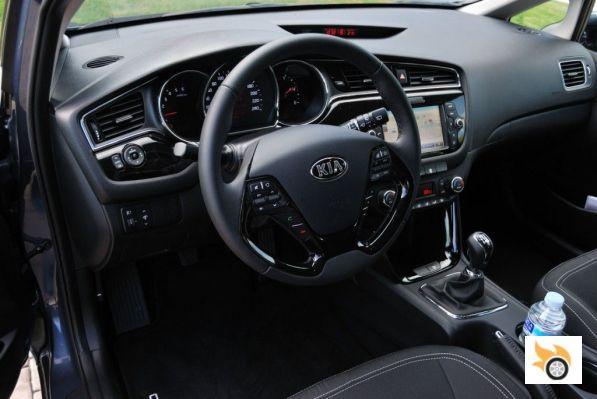
Back to the changes in the interior, there is more chrome and aluminium. In the case of the pro_cee'd GT, the steering wheel has a distinctly different shape, trimmed at the bottom. Another particularity of this version are the Recaro sports seats, type báquet, upholstered in suede. In addition, we will notice a gray stitching that makes the car more sporty, or so they believe the marketing.
There are some new features in equipment, such as an upcoming browser signed by TomTom that uses the Internet to retrieve traffic information, location of radars or weather forecast. The top of the range, with a package called Luxury, may have traffic sign recognition and adaptive headlights. The competition has been offering that for a while now, and more TV camera-based features are missing.
Kia has decided to take the same -criticiable- decision of the Asian brands, whoever wants the latest safety systems, should buy a model with more engine and equipment than necessary. At least in the first few months, they will only be available in the GT Line, the others ... remain at a level reminiscent of 2010 or a little earlier. Yes, the Kia cee'd is getting a bit outdated technologically. Just look at those two red monochrome screens on the base and mid-range models. From another era.
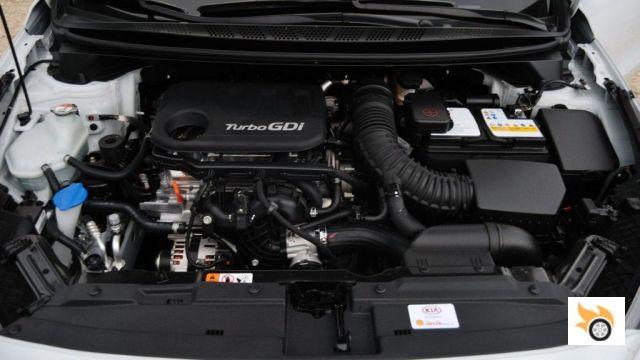
Let's talk engines: T-GDI vs CVVT
Sooner or later, the world's fifth-largest carmaker had to fall into the downsizing trend, and offers a three-cylinder engine in two power ratings: 100 and 120 hp. In principle they replace the 1.4 CVVT (100 hp) and 1.6 GDi (135 hp) engines, only the former remains in the range, and I consider it a wise decision. The new engine costs 800 euros more with the same equipment.
Kia's managers in Spain believe that our market is still not very receptive to such tight engines, and allows the customer to choose the engine. After having driven both, I'm pretty clear about it, but before I give you my verdict, I'll give you my arguments.
The 1.4 CVVT engine is a tried and tested mechanical base, with a long history, and from which sincerity is expected above all. It's an engine that has very little power at low revs, and you have to know how to drive it: the gear lever exists, and it has six gears. There's life beyond 5,000 RPM, and it's not just the badasses who drive like this, it's the power that's up there.
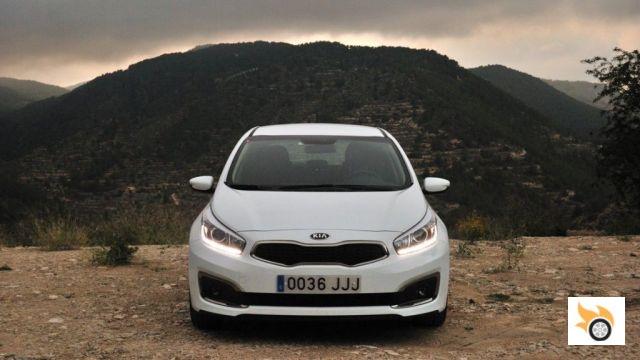
Driving smoothly, at moderate speeds, it's even easy to see fuel consumption averages below 6 l/100 km. When you see something like that on the computer, you think: "why the hell would they offer a diesel with this engine? When you see something like that on the computer, you think: "why the hell would they offer a diesel with this engine?" The 1.4 CRDi (90 hp) costs 1,150 euros more, not very easy to amortize. We can choose both engines in the five-door Concept, Drive and Tech trims.
The alternative, with more technology, resorts to a very tight engine, 100 hp per liter in its basic version, which Hyundai and Kia do not share with other brands. The only difference with the 120 hp engine is the power delivery at high revs, as the maximum torque is the same, 171 Nm, and is available during the same range from 1,500 to 4,000 RPM. Probably the only difference is the electronic engine management.
From 80 to 120 km/h in fifth gear the CVVT takes 16.9 seconds, the T-GDI 14.3 seconds.
Obviously the T-GDI engine is more comfortable to drive in the sense that as it has more power at low and medium revs, you have to move the gearbox less. Pushing the performance to the maximum, the difference is almost non-existent in pure acceleration (a tenth of a second), although in recoveries the turbo gets away with it. Top speed is also the same. Using the gearbox as it should be, the 1.4 CVVT can surely beat the 1.0 T-GDI on the track.
In general, I'd choose the CVVT without hesitation. Although it's true that the three-cylinder is better balanced than the average, it's still a worse balanced engine than a four-cylinder. In terms of consumption the new engine does not bring any advantage, the averages obtained in the test are about 8 l/100 or above, the naturally aspirated engine spends less. All the cars tested were only just running in.
The only two objective advantages of the 1.0 T-GDI engine are that it pays less road tax and that it is fuller at the bottom of the rev counter.
Otherwise, the CVVT wins hands down: cheaper, simpler, more austere, more reliable/proven, and certainly less polluting. Direct injection turbocharged engines are very suspicious of generating particulates in a beastly way, compared to the "antediluvian" atmospheric multipoint ones. And in that sense, Hyundai/Kia is just another manufacturer, the particulate filter for gasoline is neither there nor expected.
The sound of the T-GDI is cooler, a bit sportier, but it's more noticeable in the cabin. The CVVT is still pleasant below 4,000 RPM, remember that for logical reasons the naturally aspirated is more revved, about 1,000 RPM more in sixth gear. If Kia had withdrawn the CVVT from the catalog, rest assured that they would have been criticized, but they have done the right thing: let the customer decide.
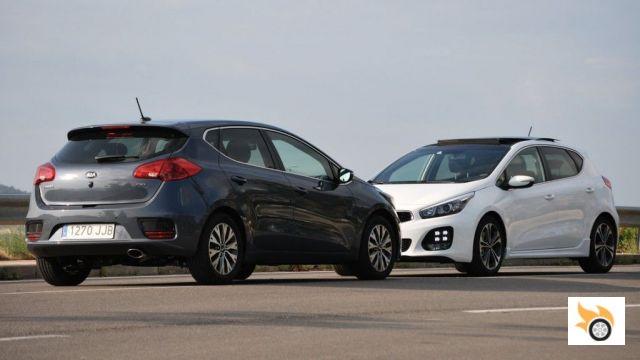
136 hp 1.6 CRDi: good vibes
As for the 136bhp diesel, it's quite a surprise how pleasant it is to drive. I'm sure Marty McFly would have said back in 1985: "That's great Doc, the diesels in 2015 are very fine!" This engine could appeal to any die-hard diesel enemy, so you take that risk. For me it's one of the best choices in the range, and that's even though my sympathy for petrols has been on the wane in recent years.
It doesn't spend a little less than the 120bhp T-GDI, it spends a lot less. On a mainly motorway journey I had no problem getting it under 5 l/100 km, it even took more than one "stretch" at not at all legal speeds. I was impressed that the isolation remains very good well above 120 km / h. Even in these conditions the engine does not have any problems. Even in those conditions the engine is not annoying at all.
Now you can have a dual-clutch automatic gearbox (DCT), a sensible and more dynamic option, but 1,600 euros more expensive.
A colleague who drove the 120 hp three-cylinder at a similar pace to mine had an average fuel consumption of 8.5 l/100 km, so in my opinion, the accounts come out flat out. The price difference is almost 600 euros, so the T-GDI is only recommended for those who get rashes at the thought of buying a diesel. I'd buy the 1.6 CRDi with my eyes closed with Loctite after mistaking it for eye drops.
You can't finish a review in Pistonudos without talking about the dynamics of the car. I thank the event organizers for proposing a very suitable route to put the car to the limit. A route of roads near Finestrat where you can find death in every curve as one is too smart, with a shattered asphalt and a dream landscape.
Compared to the pre-styling model, Kia wanted to make the cee'd more comfortable. The dossier talks about new mounts for the rear shock absorbers, new outer ball joint for the rear anti-roll bar, and changes to the front axle geometry to improve steering feel. I haven't driven the previous model, so I can't make an objective comparison.
I can attest that the cee'd can take a lot more crap than the average driver is going to demand of the car. When you want to run away from the police after robbing a bank, you'll notice it sways a bit in support changes at a suicidal pace, at least with 16″ wheels. For day-to-day driving, it's a safe car that you can trust, and one that doesn't do strange things.
The power steering has three levels of assistance: sport, normal, and comfort. I drove almost all the time with the harder option, and for my taste I prefer it even harder. Using the comfort mode, I almost had the feeling of driving a videogame console steering wheel. But this is a matter of taste and allows you to choose, thank goodness.
When you come out of a corner accelerating at full throttle, it understeers a bit, even though it's been fitted with an electronic differential. In other words, it's a brake fryer. It's absurd to put an economical locking system on a compact car with 100bhp, but the 204bhp car could do with it. I haven't driven the pro_cee'd GT, but I have driven a similar model which will be tested soon.
Dynamically, it convinced me, at least with 100 hp. I drove the 136 hp CRDi almost alone on the motorway.
I had a lot of fun on those roads, so much so, that I turned off the music to arrive alive the next day. The brakes take a remarkable amount of punishment, again well above what a driver of sound mind is going to ask for. There are more fun compacts, yes, with slightly more lively reactions. The cee'd maintains its nobility, without becoming a bourgeois and boring compact. Good job Kia.

























